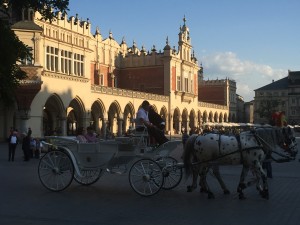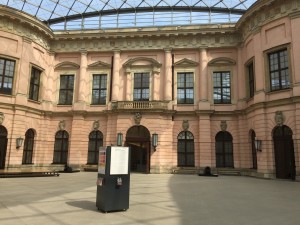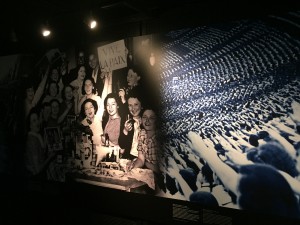As we drove across the city of Kraków, I immediately noticed how different it was from any city or town I had ever visited. It was a bit of a culture shock. The architecture and the public transportation were vastly different than anything I have ever seen. The buildings had a Tuscan flare to them; some were pink, some were green, some had huge archways, and some had high, intricate steeples. The main form of public transportation was a tram connecting wires that ran on tracks. It was interesting to see people not have to pay to use the tram.
The town square was my favorite part of the city. It was so open with many different restaurants, dessert shops, and quirky stores that sold the most unique items. There was also this clock tower in one of the corners of the square. It was so tall and so different from when I saw Big Ben in London. It was green, had a detailed steeple about fifty feet tall, and was numbered with faded, gold paint. It was so beautiful that two of the girls on the trip with me took the time to sit in the square and sketch the clock tower. The square also had about ten horse-drawn carriages that you could pay to take you for a ride around the square. I was shocked to see horse-drawn carriages because since I live in Piqua, Ohio, I have never seen one before. There was also this group of men who were in the square that had a rope attached to two sticks. The rope had many loops in it so that when he dipped the rope in soap, he made numerous giant bubbles float across the square. This was completely new to me. To see these men make bubbles for the kids running around the square was one of the sweetest and most uplifting scenes I experienced.

This is a view inside the town square of one of the horse-drawn carriages.
One of the biggest differences I noticed was how people had to pay for food and souvenirs. In the states, it is normal to receive separate checks and pay with big bills at restaurants. In Kraków, it was the exact opposite situation. The waiters and waitresses could not give us change if we used a bill worth more than twenty zloty (the currency in Poland). If a group of us went out to dinner together, they also could not separate our checks. We all had to put in the exact cost of our personal meals and pay all together. When we all went to dinner to try pierogis our first night, we had a rude awakening when almost none of us had less than a fifty zloty bill. Instead of having us all pay separately, the waiter gave us all change for our fifties so that we could then put our money together to pay for the bill all at once. We were all very confused and blatantly showed everyone in the restaurant that we were tourists.
The biggest difference in Kraków was obviously the language barrier. I was expecting to have a very difficult time trying to communicate with the people of Kraków since I do not speak a word of Polish. I was pleasantly surprised when some of them spoke some English on our first night. I mistakenly assumed that most of the people I would encounter would also understand English. Being in Poland was the first time that I have had the problem of a language barrier, especially with no one there to help translate. This woman was asking us to come into the restaurant where she was employed to eat dinner. I told her that we had already eaten dinner, but the other people I was with were intrigued by the place and wanted to ask her more information. One of the others asked her if live music was played every night, and she just stared straight into her face. She tried again and the woman still just stared at her. We decided the best thing to do was to apologize along with apologetic facial expressions and walk away from her without finding out any information about the restaurant.
The most shocking part about Kraków was the proximity of this pleasant little city to the most heinous place that has ever existed. Auschwitz-Birkenau is 68 km from Kraków; that’s about an hour drive. Walking around the town square, we saw many posters advertising tours through the labor and death camp. It was bizarre to see this place being marketed as a tourist attraction. When we arrived at the Auschwitz camp, there were multiple groups of people just standing around. Some people were smoking, others were buying food, others were buying souvenirs, and others were staring at their cell phones. As I took in the scene around me, I felt uneasy. The site felt so touristy that it made me feel anxious and uncomfortable. Once our tour began, my uneasiness only grew. I took a picture of the gate to Auschwitz that read, “Arbeit Macht Frei.” This phrase translates to, “Work Will Set You Free.” After that I took one picture of the railway that runs through Birkenau. I took both pictures outside of each camp. It felt wrong to take pictures inside of either camps, and it was infuriating to see people who took pictures of the human ashes and some who even used “selfie-sticks.”
As we were walking through Auschwitz, I did not process we were really where so much murder took place until we entered the room filled with two tons of human hair found at the camp when it was liberated in 1945. I expected to see the suitcases, shoes, and random belongings. I never expected to see human hair. I immediately began to cry and tried everything I could to keep myself together while we were in that room. I was able to keep my cool until we visited one of the death barracks in Birkenau. These barracks were where they kept the people who were next to be gassed. When I saw the scratchings in the walls, I assumed that it was the prisoners that might have scratched their own names into the walls. Our tour guide then told us that it was graffiti from people who visited the site after the war before it was a tourist destination. My mouth dropped. I could not and still cannot believe that someone could be that ignorant and that disrespectful. When we left the site, I rode the bus back to the hotel in silence.
I still do not think I have processed my experience at Auschwitz completely. It is unreal to think that we were all standing in the same spots that so many people were murdered. It is sickening to me that I fell in love with a city that offers a deal on tours of this monstrous place. How could such an amazing city be so close to a place that symbolizes evil and death?

This is a view from the front of Birkenau. Through the fence, the train tracks can be seen going straight to the back of the camp.
Almost everything about the city was different from my small hometown in Ohio. Kraków has been the only place so far where I truly felt like I was in a foreign country. The language barrier was not as intense in England or France. I was introduced to new architecture, a new public transportation system, a town square, a horse-drawn carriage, and a completely different language. It was a culture shock, but it has been my favorite city so far as well.









